Everything You Need to Know to Hike to Havasu Falls—and How to Get a Coveted Permit
This article originally appeared on Outside
Photos of the breathtaking Havasu Falls tumbling over red cliffs and ending in a Gatorade-blue pool were popping up all over social media--until they stopped. Visitation to this outpost of the Grand Canyon ceased in March 2020, upon the arrival of the pandemic. Three years later, as of February, the falls have reopened on a limited basis.
Given that the falls are bucket-list status, it has always been challenging to get a permit to hike there, especially so this year. No new reservations or permits will be issued this year, but existing ones made prior to the onset of COVID-19 will be honored. As stated by Havasupai Tribe Tourism on Facebook, “Only those reservation holders that were impacted by the COVID tourism suspension have a confirmed reservation. The only way to get a reservation for 2023 is to purchase off the official transfer list” for cancellations.
To track cancellations, watch this website closely, and be aware that you must sign up for an account to see availability. The above Facebook page has good information as well.
DON’T LOSE HOPE: check the cancellations daily, or start dreaming and planning for next year. New permits will be issued again starting in February 2024.
Whenever you can get the chance, this is what to expect during the hike and the best way to do it.
How to Reach Havasu Falls
These falls and their sister falls--Navajo, Mooney, and Beaver--are among the Southwest's most awe-inspiring natural wonders. The falls don’t technically lie within Grand Canyon National Park's boundaries. They are located on the Havasupai (meaning people of the blue-green waters) Reservation and are inaccessible by road.
A trip to Havasu Falls isn't for the casual visitor. Not only is it a long and steep 10-mile hike to the falls, but even in normal years you need to secure a competitive lodging reservation, which also serves as a permit, in advance. Day hikes are not allowed. The challenges you'll face in actually getting to the falls, however, are well worth it when you drop your pack and swim in those waters.
Visitors to Havasu Falls spend their time swimming, hiking to the area's other waterfalls and attractions, and soaking in the stunning views. While you'll be surrounded by natural beauty, you definitely won't feel a sense of solitude while hiking to and staying on the Havasupai Reservation. Within the canyon are accommodations for several hundred people, and visiting is so popular that every space is full all season. As long as you don't mind enjoying the scenery with other hikers, this spot is still well worth it.
How Long Is the Trail to Havasu Falls?
The trail to Havasu Falls is 10 miles one way, or 20 miles roundtrip. However, you'll want to account for some extra mileage to hike to the other beautiful waterfalls in this canyon and to reach your campsite, which may be past the falls.
From the parking lot, descend 1,200 feet in the first mile as you tackle steep switchbacks through beautiful red sandstone to the flatter ground of a dry stream bed. Follow the trail as it gradually descends over another seven miles, and at a junction, follow the sign that points to the village of Supai. The desert transforms into a lush oasis as you hike along Havasu Creek and then arrive at Supai. Check in at the Tourism Office and show your reservations to get mandatory wristbands for everyone in your group.
From Supai, continue another two miles to the campground. You'll catch your first view of Havasu Falls, the last 10 miles evaporating from your mind as you take in the turquoise waters. There's one more steep descent to the campground.
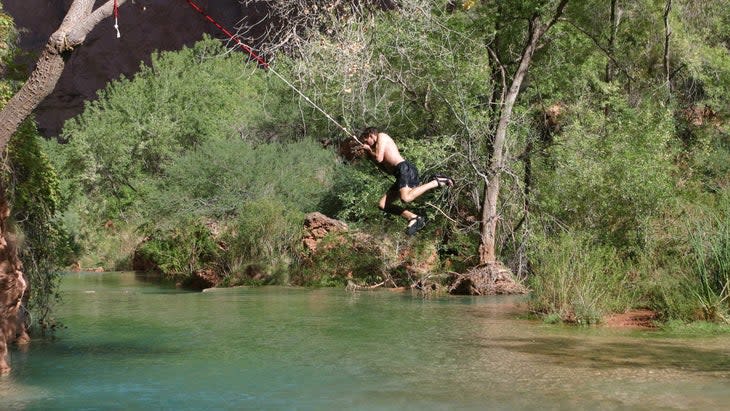
How Difficult Is the Hike to Havasu Falls?
The difficulty depends on your abilities. Seasoned hikers might find the trek moderately difficult, but if you lack experience, it’s likely to feel pretty grueling. Train for your trip by hiking or hitting the gym with a loaded backpack to ensure that you're feeling fit and ready.
From the trailhead, you'll descend 2,500 feet to the campground over 10 miles of hiking. That means 2,500 feet of climbing on the way back up at the end of the trip, too. While that distance and elevation might not seem overly difficult for experienced hikers, wearing a loaded backpack and hiking through the shade-less and extremely dry terrain can make it more intense.
To have the best possible experience, avoid planning trips at the height of summer, when midday temperatures can easily top 100 degrees. Start both ways as early as possible to avoid the heat of the day. The trail is closed overnight, so 4 a.m. is the earliest you could begin.
The trail starts at more than 5,000 feet above sea level, so drink plenty of water to avoiding dehydration and altitude and heat sickness. There are no water sources along the trail, so you'll need to bring enough for the entire hike in and then out again (water is available at the destination). The Hualapai Tribe recommends a gallon of water per person for each leg (out and back) of the hike. A gallon of water weighs 8.3 pounds, something to know as you're packing your backpack.
Alcohol is strictly prohibited on the reservation--yes, really, you can end up in jail for a year if you ignore this law--so put the extra weight that might have been taken up with an apres beverage into hauling all that water. Proper sun protection, like a hat with a brim, lightweight long-sleeve layers, sunglasses, and sunscreen are also important for hiking in the desert.
The steep switchback sections can be pretty gnarly on the knees, but trekking poles will take some of the load off your joints and help you balance.
When Is the Best Time to Visit Havasu Falls?
The hiking season for Havasu Falls is February through November.
In the summer months of June through September, the heat can get merciless in the canyon. Daily highs often top 100 degrees and nightly lows stay above 70 degrees. While these temperatures can be doable at the bottom of the canyon where you can cool off in the creek or find shade, the temperatures along the trail up and down are fierce. If you do plan a summer trip, start your hikes in and out very early in the day. Flash floods can occur in the summer months when monsoon rains drop large amounts of water on the hard desert floor in a short amount of time. Even if there isn't rain on the reservation, flash flooding can still occur from nearby storms. Always check the weather forecast before starting out and if you hear or see flood waters approaching, get to high ground immediately.
The best times to plan a trip to Havasu Falls are the spring and fall months. Highs are in the seventies and eighties, and the lows rarely dip below freezing at night.
The colder months of February and November may be the easiest times to get permits. While snow at Havasu Falls is pretty much unheard of, temperatures will likely drop below freezing at night and hover in the fifties and sixties during the day. Since campfires aren't allowed, pack plenty of warm layers and a warm sleeping bag.
How Do I Get a Permit to Hike to Havasu Falls?
The answer is with a little bit of preparation and a ton of luck. Day hikes are not permitted to Havasu Falls, so you need to either make a camping reservation or a reservation at the lodge in the village of Supai, two miles from Havasu Falls. Don't even think about attempting to visit without a reservation. You may need to show either your camping or lodge reservation to drive to the trailhead.
As noted above, unless you have a delayed permit, the only way to visit in 2023 is to grab a cancellation. For 2024, keep in mind that reservations are extremely popular and often sell out as soon as they become available. Create an account on www.havasupaireservations.com before the reservation window opens, and add in all your personal and payment information so you're ready on the big day. Be ready to reserve right when reservations open and be prepared to be flexible on your trip dates.
If you aren't able to make a reservation, keep an eye on www.havasupaireservations.com for the list of cancellations, which gets updated at 8 a.m. MST each day. If you see a reservation that works for you, you can book right away.
Be sure to specify a Potential Alternate Trip Leader in case you aren't able to go on the trip. Reservations can't be transferred, so the rest of your group will be out of luck unless you specify an alternate to take your place as the trip leader.
Where to Stay at Havasu Falls
There are two types of reservations for staying on the Havasupai Reservation: camping or staying at the Supai Lodge.
The campground is located 10 miles from the trailhead and spans a mile along Havasu Creek between Havasu Falls and Mooney Falls. You won't be making reservations for an assigned campsite, just for the dates of your trip. Once you arrive, you can set up camp anywhere in the designated camping area.
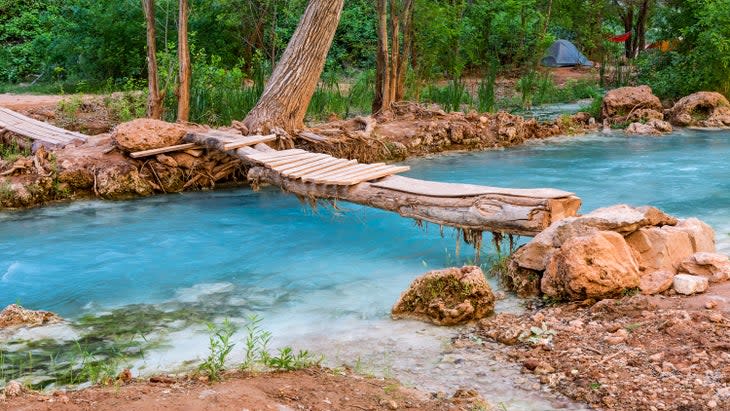
All campground reservations are for three nights and four days. This gives you plenty of time to explore the canyon as well as rest up for your return hike uphill. Composting toilets and drinking water are available at the campground. Campfires and flames of any kind other than gas-powered cooking stoves are prohibited.
The other option is to make a reservation at the Supai Lodge, located in the small village of Supai. Supai is two miles from Havasu Falls and is where the tourist office, museum, lodge, store, and cafe are located. You can reserve four-person rooms (two queens) at the lodge. Accommodations are basic, but each room has air-conditioning, heat, and hot showers.
The Supai Cafe is usually open from 8 a.m. to 5 p.m., though the hours may vary. It serves burgers, fries, and Indian Tacos, made with fry bread. The Supai Store sells drinks, ice cream, travel-sized toiletries, and canned goods. Because of the remote location, inventory may be limited, and prices will be expensive. Better to bring your own supplies.
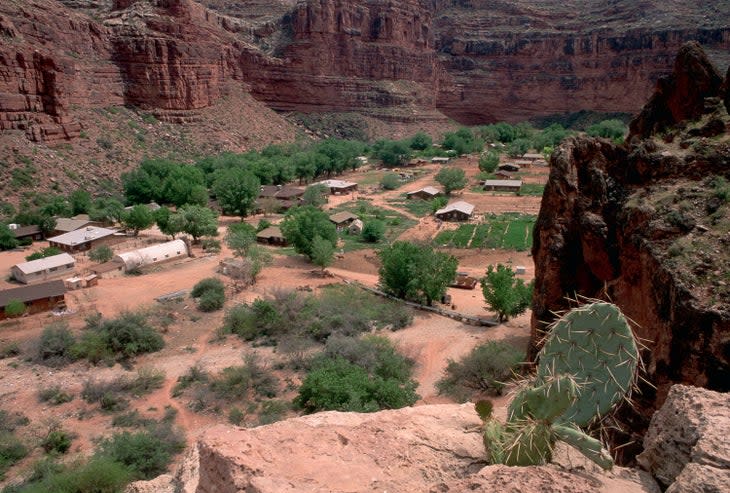
In the past, some tour companies were able to obtain permits to guide clients to Havasu Falls, but in 2019, the tribe suspended commercial use permits for the foreseeable future.
The tribe also offers pack mule reservations to shuttle your gear from the trailhead down into the canyon. However, we suggest steering clear of the pack mules and instead experiencing the sense of satisfaction you'll get when you make it to Havasu Falls with all your gear on your own back.
How Much Does It Cost to Go to Havasu Falls?
Camping reservations for Havasu Falls include three nights and four days for $395 per person. Rates at the Lodge are for four people and include three nights and four days of lodging. Each reservation costs $1,980. When staying at the Lodge, you will also need to pay a $40 deposit per night and a $50 per person entrance fee, plus taxes.
How Do I Get to Havasu Falls and Havasu Creek?
The only way to get to Havasu Falls and the beautiful Havasu Creek is to hike 10 miles with your gear either in a backpack, or carried by a pack mule.
The closest major towns to the Havasupai Trailhead are Kingman and Williams, Arizona. It's a great idea to stay in one of these towns the night before your hike to help get an early start on the trail.
From Kingman, take Historic Route 66 east just past the town of Peach Springs. Take a left on Indian Road 18 and continue 60 miles to the end of the road at the Hualapai Hilltop Parking Area. From Williams, take I-40 west to Route 66 and then Route 66 west to Indian Road 18. The turnoff will be on your right from this direction. Indian Road 18 is paved the entire way so any vehicle will get you there without problem. Both routes take approximately two hours and 15 minutes.
There are no gas stations or services along Indian Road 18, and no gas stations in Peach Springs. Fill your tank up before leaving Williams or Kingman.
From the parking lot, the trailhead is very easy to spot.
Can You Swim in Havasu Creek?
Cooling off in the waters of Havasu Creek and enjoying the beautiful pools at the base of the various waterfalls are among the main attractions of the Havasupai Reservation. Water temperatures remain approximately 70 degrees year-round, but the air temperature can make swimming feel pretty cold in the early spring and late fall.
Bring water shoes or sandals with good treads, like Tevas, to protect your feet as you scramble over sandstone to explore the creek. Packing a swimsuit is a good idea, but if your swimsuit doesn't have great coverage, you may also want to bring a pair of quick-drying shorts or board shorts and a quick drying T-shirt or rash guard to protect your skin on rough surfaces.
Cliff jumping is not allowed in any of the pools under the waterfalls, as the pools are fairly shallow and jumping can be extremely dangerous. There are no lifeguards at any of the waterfalls, swimming holes, or the creek, so swim at your own risk and keep a close eye on small children. Pool floats, kayaks, stand-up paddleboards, and pretty much anything else you might play with in a body of water are not allowed.
Day Hikes from Havasu Falls Campground
Flooding in October 2022 destroyed several bridges and trails and changed some of the waterfalls on the Havasupai Reservation. Once you have obtained a permit, check with the Havasupai Reservation for up-to-date information on area trails.
Navajo Falls
Navajo Falls is the first waterfall you'll encounter after the village of Supai. It's 1.5 miles from the village, and half a mile before the campground.
In 2008, a flash flood changed the flow of Navajo Falls, creating two waterfalls where there was once only one. The Lower Falls plunge 30 feet and end in a nice swimming hole that's often less crowded than those below the other waterfalls.
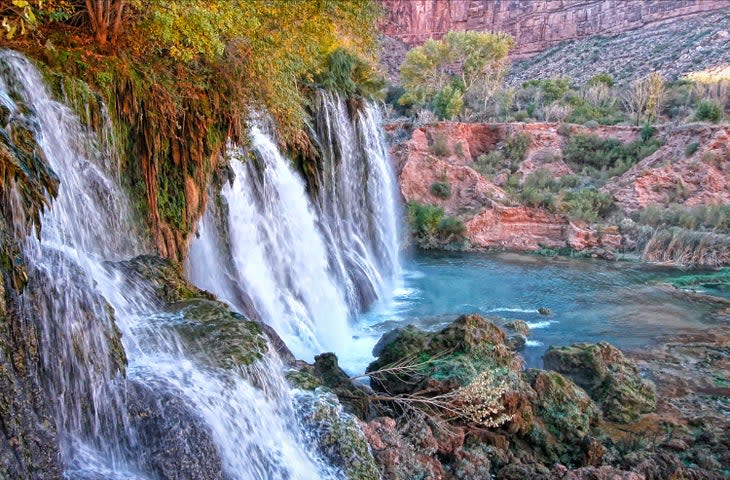
Havasu Falls
Havasu Falls is located two miles from Supai, at the camping area. This stunning 100-foot-tall waterfall cascades over vibrant red rock into a turquoise pool.
While more powerful than Navajo Falls, Havasu is still mellow enough that you can swim behind the pouring waters and enjoy the approximately five-foot-deep pool at its base.
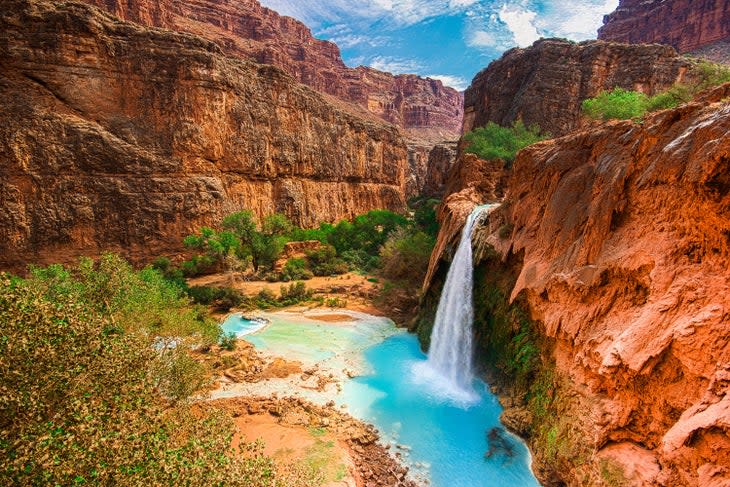
Mooney Falls
Mooney Falls are located another mile past Havasu Falls. These are the most dangerous of all the waterfalls, as the approach trail is narrow, steep and often slippery. You'll have to descend a cliff face using chains and ladders to reach the bottom of the falls.
The falls tumble 200 feet down into an approximately 15-foot-deep pool. Mooney Falls may feel colder than the others since the spot often shaded, so dress accordingly. Crowding can occur on the route, so plan your hike for early in the morning or late in the afternoon to avoid congestion on the narrow trail.
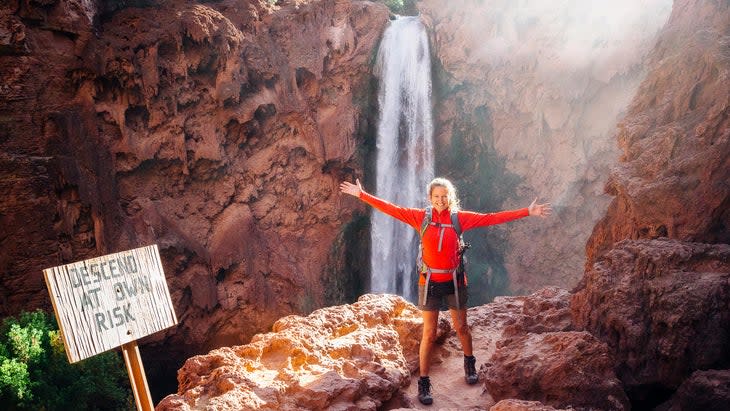
Beaver Falls
Beaver Falls is located three miles from Havasu Falls, making it a long, six-mile roundtrip hike from your campsite, but the incredible view is worth it.
Unlike the other waterfalls that plummet long distances, Beaver Falls tumble down Havasu Creek through exceptionally beautiful pools.
You'll have to climb down to Mooney Falls and then continue along the trail hugging the western canyon wall. As you leave the Mooney Falls area, you'll see more ladders leading up into the cliffs. Don't climb them out of respect for the Havasupai, as they lead to a historic burial site.
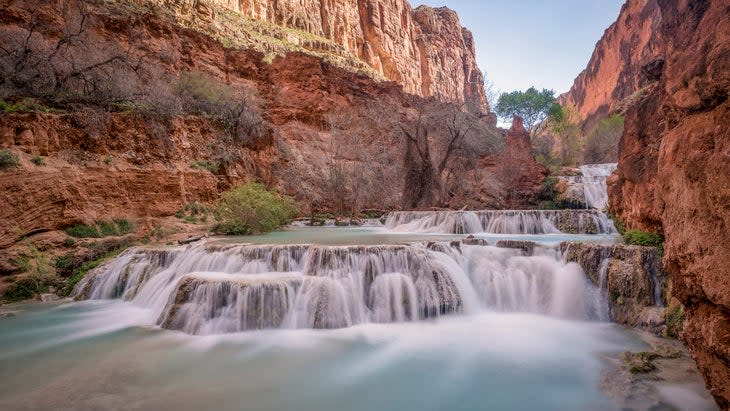
You'll encounter at least three creek crossings as you head to Beaver Falls, so bring along your sandals or water shoes. At a point where you encounter a seemingly out-of-place date palm tree, either cross the creek again and journey up the creek itself to the upper falls, or take a sharp right and follow a trail on higher ground to a section of ladders that will lead you to the lower falls.
Past Beaver Falls, it's possible to leave the Hualapai Reservation and hike to the confluence of Havasu Creek and the Colorado River, but this 16-plus-mile roundtrip hike from the campground is not recommended, as the route is unmarked and lies outside of the reservation, meaning there are no rangers to help if you get into trouble.
How to Respect the Land and Havasupai Tribe
With more than 300 people staying on the Havasupai Reservation each night, it's important to do your part when visiting to respect the natural wonders of the canyon and the tribe whose homelands you're staying on.
First, practice Leave No Trace principles. Every item you bring in, from granola-bar wrappers to toilet paper, needs to be packed out and disposed of properly when you get back to your car. Use the toilets in the campground, and don't urinate or defecate near or in Havasu Creek, as it contaminates the waters for everyone else.
Camp on durable surfaces. Because all camping on the reservation is choose-your-own-site, it's important to find a place to pitch your tent that will minimize your impacts. The same goes for exploring the various waterfalls and creeks. Stay on the main trails and avoid following or making your own desire-paths, as they can really impact fragile plant growth.
Store all your food and scented items in a bear canister. While there aren't any bears in the canyon, plenty of small critters will get into your food and toiletries if you don't store them properly.
The second way to respect the land you're visiting is by adhering to all the Havasupai Tribe's rules and policies. These include: no alcohol or drugs of any kind, no playing music or being loud or disrespectful, and no flying drones. You aren't allowed to photograph Havasupai people or Havasupai property, including the buildings in Supai. Remember, you're visiting someone's home.
Familiarize yourself with the history and the culture of the Havasupai people before visiting to ensure you can be the best guest possible.
This story was first published in Outside's sister brand National Park Trips. In addition to eight websites, each one dedicated to a national park, National Park Trips publishes four magazines a year, providing expert travel service on Grand Canyon National Park, Colorado’s national parks, Yellowstone National Park, and Yosemite National Park. National Park Trips also provide free trip planners for many parks. See the Grand Canyon trip planner here.
For exclusive access to all of our fitness, gear, adventure, and travel stories, plus discounts on trips, events, and gear, sign up for Outside+ today.

